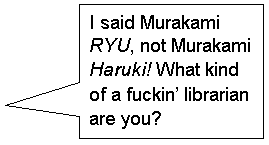
by
Peter
and Naoko
The author was born in 1952 in Nagasaki as Murakami Ryunosuke. In 1976 he won the prestigious Akutagawa literary award for Almost Transparent Blue, the youngest to do so until that time, as well as several other prizes, for his first novel Almost Transparent Blue (1976), a grotesque, yet lushly written semi-autobiographical novel that tells the tale of slacker hippies who hang around the US army base. These prostitutes and junkies have the occasional orgy with black jazz-playing servicemen, and the group dynamics are fascinating; the short, intense book has sparse dialogue and a lot of Baudelarean poetry. Coin Locker Babies (1980) is a longer novel about a dystopean near-future Japan and the adventures of a pair of twins who were abandoned by their mother in a coin locker shortly. Separated, one of them becomes a transvestite hustler and pop star, while the other excels at pole-vaulting; this strange book concludes in an orgy of extreme nihilistic violence that made deep and shocking impressions on most of the people who read it at the time. 69 (1987) is sweet and humorous autobiographical tale of adolescence. It is about a high school kid trying to impress the most beautiful girl in his school by organizing a rock festival the rural Japan of 1969, while cataclysmic changes are occurring all around the country – riots, school strikes, communist terrorism, and more!
Murakami Ryu has also directed several movies: Almost Transparent Blue (1980), the terrible Farewell My Friend (1983) with Peter Fonda, the atrocious Raffles Hotel (1987), the middling Tokyo Decadence (1992), and the so-so Kyoko (1995). He may be a good writer, but nobody really considers him a good director. His greatest film success so far has been with the poignant yet gruesome Audition (1999), directed by Takashi Miike (Ichi the Killer, Dead Or Alive, etc.) from his novel. The 2001 baseball movie Harhire Ichiro (Run! Ichiro!) has also been filmed from his book Hashire! Takahashi! (Run! Takahashi!).
Murakami Ryu will also write about anything under the sun, and has books about wine, cooking, soccer, tennis, golf, making email friends (a Japanese passion), economics, etc. Some of his fascinating novels that deserve translation include the following:
The
Fascism of love and Illusion (1987) Sequel to
Coin
Locker Babies. Set in the near future, Japan’s hopeless
situation is
similar to the one before the second world war. A charismatic former
hunter
politician called Toji appears as a political leader. His austerity
policy is
that of the hunter: only the strong survive. Some support him to be a
leader of
Japan, and these people try to get rid of his opponents, even through
violence.
None of the same characters as the first book show up.
Topaz (1988) a short story collection that includes the story that is the basis for the film Tokyo Decadence, about the misadventures of a young woman who works for an S&M agency. She is a masochist who falls in love with a celebrity client and tries unsuccessfully to stalk him. Another story tells of a fat, ugly, lazy prostitute with psychic abilities: born with a “twin” side to her brain, a voice that talks to her and warns her to stay away from people who probably want to use her in a snuff film they are making. Another story tells of a widower/ devoted father who comes home one day to find a strange woman living in his apartment.
  |
Ibiza (1992)
– Similar to Ecstasy. A
friendless woman called Machiko, just released
from a mental hospital, meets a mysterious guy. He promises her a
luxurious trip
to Paris, where she meets lots of strange people. Anybody who becomes
her
friend dies or goes crazy. She starts “seeking herself” so she leaves
the rich
guy; of course, there is plenty of sex, demonic possession, romantic
love, etc.
Finally she meets an old woman who whispers to her “go to Ibiza.” She
does and
has more adventures, until the ultimate shocking violent conclusion
that brings
her her ultimate peace of mind.
Ecstasy (1993) –
this is the story about
the drug ecstasy. The narrator meets a homeless man in New York called
Yazaki,
and his girls. It is mostly about sex and drugs, but it is also about
seeking
extreme happiness within yourself. Yazaki then tells him to go to Paris
to meet
a woman. Yazaki seems like a harmless guy, but eventually it is
discovered that
he is a supreme manipulator and controller of people. The narrator
finally
becomes a drug carrier to Japan after being corrupted by Yazaki and his
girls,
he now does this type of risky job for fun, not for the money.
Kyoko
(1995) – Kyoko is a young dancer who carries with her warm memories of
a
Latin-American U.S. army serviceman who taught her her first dance
steps when
she was a little girl. When she turns twenty, she leaves her job as a
truck
driver and flies to New York to look for this man. What she finds is
the
tragedy that his life has become, and she devotes her life to helping
him. This
dramatic tale has none of the sex and drugs of many of Murakami’s other
novels;
Murakami also directed a film of this book, dialogue mostly in English.
In the Miso Soup (1997) –
Serial publication in Yomiuri Shinbun newspaper in Japan, also
published as a book. The main character is an English-speaking Japanese
man who
works as a translator and tour guide. As a guide he mainly takes
tourists
around Tokyo’s sleazy underworld. He gets a call from an American guy
called
Frank. When he meets Frank he feels unease; at the same time there are
a series
of violent incidents in Shinjuku – teenage girls are killed and dumped
in the
garbage. Somehow while he is showing Frank around, the image of these
murders
flashes in his mind. At one of these places, with lots of sleazy
hostesses,
Frank suddenly gets up and just kills everyone. While Murakami was
writing this
story, the Kobe beheading incident of a young retarded boy by a junior
high
school student occurred and occupied the news. Many readers were
freaked out by
his series and wrote to complain to the author.
Audition
(1997) – A movie producer and father of a high school-aged boy, who has
been a
widower for ten years, decides it is finally time to start dating
again. Not
knowing how to meet women, a friend suggests they set up an audition
for a fake
film as a way for him to “screen” likely contestants. After talking to
dozens
of women in this way, he is finally smitten by the angelic girl of his
dreams
and fantasies. He woos her and as they consummate their relationship,
she
extracts a promise from him, then disappears. She later turns out to be
a
psychotic killer.
What
Could
Have Been Bought With All That Money: Bubble Fantasy (1999)
With the illustrations of Hamano Yuka, Murakami analyses other ways
that the
7.4 trillion yen that the government used to save the struggling banks
of Japan
may have been used. How many pencils may have been bought, how many
Sammy
Sosas, how many Yahoos, etc. Absurd and sad.